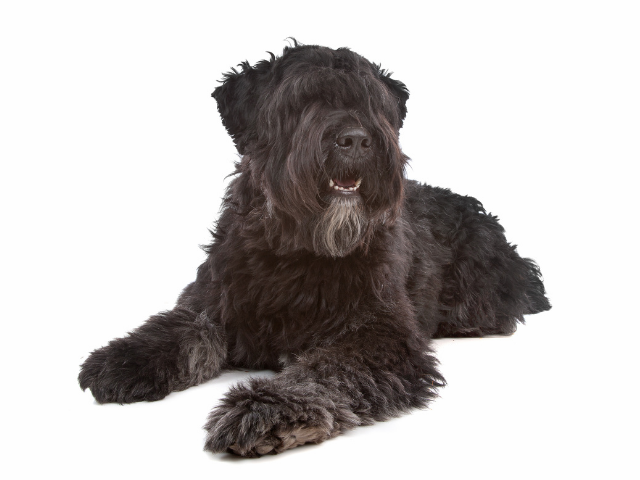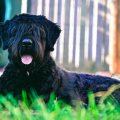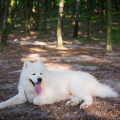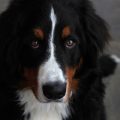Table of Contents
If you’ve been considering adding this beautiful, distinctive breed to your family; here are some interesting facts and quirks about the Bouvier des Flandres that might help you make up your mind. Or, if you already enjoy the benefits of having a Bouvier des Flandres as part of your family; knowing more about what sets them apart from other dog breeds would make you better appreciate the unique brand of personality they bring into your home.
The Bouvier des Flanders lived through a good part of European History
The Bouvier des Flanders is believed to have been bred originally in a monastery. The Ter Duinen Monastery was a rich and influential Benedictine Order in what was once the County of Flanders; which was geographically located in what is now Belgium. The monastery evidently had extensive landholdings on which the monastery grew; and reared sheep, and the wool they produced was put into trade by the monks.
This likely tie into the monastery’s need for a reliable working dog. In fact, the monks were widely known to be dog breeders, and it was through their efforts that the original ancestor of what is now know as the modern Bouvier des Flanders came into existence.
So, the ancestor of the Bouvier des Flanders was put to work, and it performed magnificently. It was practically tireless, herding sheep, guarding cattle, and even pulling carts. Its name; in fact, can be loosely translated from French to “cow herder of Flanders.” It was a strong and reliable breed and had the endurance to withstand the elements due to its thick coat. It was intelligent, docile and obedient, and so was very much like a gentle working giant.
The powerful and wealthy County of Flanders, however, was not meant to last. It rode the wave of the tumult created by the Hundred Years’ War, was briefly a territory of the Habsburgs of Austria; was under Spanish rule after the Spanish occupation, and then ceased to exist during the French Revolutionary Wars when it was annexed by France and split into what are now West Flanders; and East Flanders of Belgium and the Zeelandic Flander province of the Netherlands. Amid all that territorial trading, the Bouvier des Flanders laid claim to the hearts of at least two countries; and to this day, both France and Belgium claim this dog to be their native breed.
So, the Bouvier breed was as much a key player throughout both World Wars; and while they may have not been actively drafted into military service, they served all the same. It was right there in the trenches, right alongside the soldiers, and suffered just as much in terms of the numbers of casualties. The breed came right near extinction – twice: first during the first World War, and again during the second World War.
So, the Bouvier des Flanders is a comparatively old breed that has survived all the way from the old world, made it through the medieval ages, saw the golden age; and eventual fall of its country of origin; and right through the two world wars that devastated the world. They likely would not have survived without the efforts of dog lovers and breeders that worked to keep their numbers up. Think of the perspective of such a breed; the stories they could have passed on to their young ‘uns if they could talk and we understood them; and how lucky we are to still be able to count them as part of our present-day lives.
Bouvier des Flanders are intelligent and highly adaptable
Not sure if you want a quiet apartment dog, a family dog that can play well with kids, a dog that can thrive at a farm, one that can protect you and guard your house and your family; a companion for an active lifestyle, or maybe an assistance dog to help you where you need aid?
Knowing what you now know of this breed’s long and interesting history; would it really surprise you that they would be a good choice for any and all of these things? They are flexible, adaptable, and highly intelligent. They are an easy to train breed with a seemingly unique intelligence that they bring to the mix. So depending on what function you would like them to take on, train them well and they will pay attention and they will learn.
Despite their massive size, they are not known to be aggressive dogs; but they can be fiercely protective of their families. They are fully capable of standing guard over your house and family; and yet they are gentle enough to be good playmates for young kids. They can thrive in farm lands where they have a chance to explore; flex their legs and maybe herd some cattle, and yet they are perfectly comfortable living as an apartment dog, too – provided, of course, that their daily exercise and grooming needs are met.
This is a breed that was fully utilized during the wars to sniff out hidden landmines and ammunition. These days they are just as useful serving as trackers, retrievers, police dogs, and even guide dogs. If you have a disability where the assistance of a trained dog would be of immense assistance to you; consider the Bouvier des Flanders. Anything you need they can probably take on, and they’ll do so with grace and much dignity.
That’s because this dog isn’t given much to flights of fancy or excessive displays of nervousness or excitement. He’s more the quiet, reserved type with the strong silence and quiet devotion. And well, it seems obvious that they’ve earned the right and privilege to be lovable and gorgeous without the unnecessary duty of having to try so hard.
Owners need to be adaptable to the Bouvier des Flanders, too.
So yes, the Bouvier des Flanders is a good breed for any occasion; but that doesn’t mean that just anybody can be their owner. They adapt well to whatever our needs maybe, but they also demand a certain adaptation from their owners, too. Being a large breed, the Bouvier des Flanders requires regular exercise to stay in optimal shape. Although they can be perfectly content living in apartment settings or closed houses; that doesn’t mean that you, as their owner, can forego their daily exercise needs. Having a backyard where they can stretch their legs would be useful; but really what they need is their daily walk and exercise, and some time for regular play, as well.
And that intelligence that this breed is known for requires some mental exercise and stimulation, too. Don’t let all their good sense and readiness to learn go to waste by neglecting to provide them with training and mental stimulation. Quite apart from the regular tricks of the trade for all dogs; this working dog would be just as happy being a productive member of society. They are guard dogs, assistance dogs, retrievers, canine police dogs and even sniffers of contraband. For a time during the wars, their services were even utilized as messenger dogs; even though they were never members of the union of postal workers.
They can be invaluable assistance dogs to any member of your family who may need support; even if it is simply companionship. But even if your family is not really in need of an assistance dog; seeing the range of what your Bouvier is capable of can be an enriching experience for both you and your Bouvier.
Finally, this gentle giant’s easygoing; and laidback ways is balanced quite finely by a whole lot of effort required of you in one particular respect: grooming. That distinguished appearance comes with a price. The Bouvier requires regular grooming, or you’ll have a hairy mess on your hands. Sure, they may not shed as much as you expected; but that doesn’t mean that their thick and dense double coat doesn’t need work.
The rough outer coat is particularly susceptible to tracking leaves, dirt, mud; and whatever else, right into your home, and given this dog’s daily exercise needs; all that outdoor stuff can quickly pile up over time if you don’t stay right on top of it. And right before and right after the cold winter season; roll up your sleeves and prepare for some intense brushing and grooming to help remove the soft undercoat. For that matter, watch out for your Bouvier during the summer months to make sure they don’t overheat. That thick double coat isn’t so comfortable during the warmer months.
And if that wasn’t enough, you should prepare for slobbery kisses, too – not so much because they tend to slobber, but because that peculiar beard; and mustache on your dog’s lovable face absorbs water. So whether he’s playing in the snow, playing around with water, or simply drinking, he will drip. Trimming around the eyes and mouth may help – a little, but really, why trim too much when this breed looks so adorable with his shaggy looks? Even the Dutch would agree – they named this dog “des preux vuilbaard” which means “dirty beard.” Because that is precisely what the Bouvier is, and they make no apologies for that. And they don’t need to, either.
The Bouvier’s General Appearance and the AKC Standard
The AKC sets out what is considered to be “perfect” standards for each breed; and the Bouvier des Flanders was recognized by the AKC as early as 1931; although it was first exhibited in a 1910 dog show in Brussels. The breed’s standards have not changed dramatically since then, and still emphasizes the best of what this dog has to offer. We know that the Bouvier has a thick, double coat comprised of a rough outer coat and a fine; soft and dense undercoat. It can come in the standard colors of black, brindle, fawn, gray brindle or pepper and salt, with no markings. Over-trimming is not recommended, nor is letting the coat grow too long. Any trimming; which should only be done once or twice a year, should only accent the dog’s natural physique, and not change its appearance completely.
Being a large breed, it is both powerful and graceful. The dog’s natural intelligence should also be apparent in its dexterity, fearlessness, strength and agility. And as we have already seen, this dog’s temperament is calm and unflappable, without sacrificing any of its natural good sense. In its natural state, the Bouviers have short hanging ears and a pretty hefty tail. Most of the Bouviers you may see around these days have what are called docked tails and cropped ears, which is a short way of saying that their ears and tails have been clipped, too. Historically; this was done to prevent accidents while the Bouvier was on the job, to prevent unfortunate instances of unintended amputation.
Mostly, this practice is now considered cruel when they serve no practical purpose; but the AKC does still allow for Bouviers that are shown sporting these features. So if the ears are cropped, the ears have to be triangular and proportional to the head. The tail, on the other hand, has to be docked, according to the standard, set high; carried upright, and no shorter than 2 or 3 vertebrae. Interestingly, and perhaps due to the long practice of tail docking, some Bouviers are actually born without a tail.
The Unique Face
Finally, we come to the dog’s crowning glory: it’s impressively massive head and unique face. It is perhaps what gives this breed its distinctively adorable look; what with the bushy eyebrows through which you can see a set of clear, dark-rimmed, dark brown eyes. And on its broad, rounded muzzle, the Bouvier sports a thick, biker-worthy mustache and beard. Regardless of how closely your Bouvier meets these “standards,” and you likely won’t care as much if you don’t participate in dog shows, the important thing is to keep your Bouvier well-groomed; happy and healthy.






 Author and long-time animal lover. Sharing knowledge on pet care through experience and the written word.
Author and long-time animal lover. Sharing knowledge on pet care through experience and the written word.